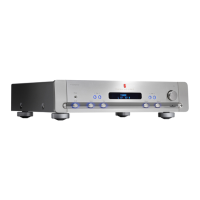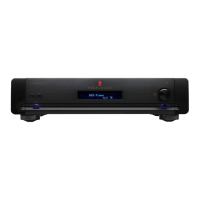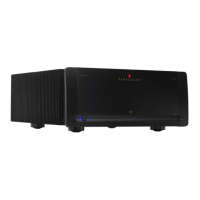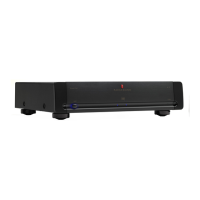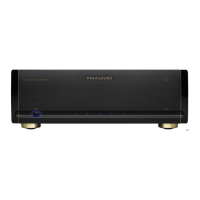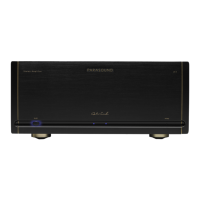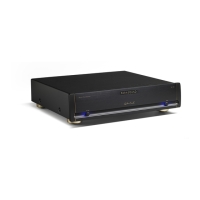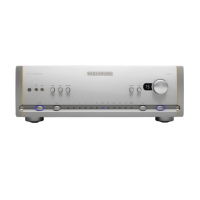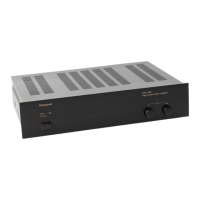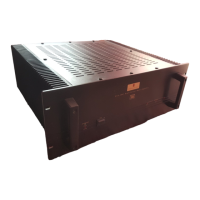Do you have a question about the Parasound Halo Integrated and is the answer not in the manual?
Expresses gratitude and introduces the product's quality and performance.
Instructs users to record serial number, dealer info, and purchase date for warranty.
Details warranty validity based on authorized dealer purchase and serial number.
Guides on safely unpacking the unit and checking for shipping damage.
Provides recommendations for optimal placement and cable routing.
Specifies necessary clearance and conditions for proper ventilation to prevent overheating.
Details how to remove feet and use a rack mount kit for installation.
Explains connecting turntables and selecting the correct cartridge load for optimal sound.
Details the three-position switch for MM, MC 100Ω, and MC 47kΩ cartridges.
Describes the sensitivity and compatibility of RCA inputs 1 through 5.
Explains the use of balanced XLR inputs for superior noise cancellation.
Details the 3.5mm stereo mini jack for portable devices.
Explains routing L/R channels to the power amp stage, bypassing the preamp.
Clarifies that the receiver controls volume and bass management in bypass mode.
Guides on connecting receiver/processor preamp outputs to the Halo Integrated's bypass inputs.
Explains how to activate the bypass mode via remote or front panel.
Details the optical input's capabilities and cable handling advice.
Explains the coaxial input and recommended cable types for stable signal.
Covers connecting PCs/Macs via USB for high-quality audio playback.
Advises setting AV device digital output to stereo PCM for compatibility.
Guides on installing drivers and setting the Halo Integrated as default audio device.
Explains connecting Macs without driver installation and setting as default audio device.
Describes how to select the USB input and play music from a computer.
Describes the binding posts and compatibility with various speaker wires/connectors.
Explains using Pre Out jacks for external amplifiers or stereo subwoofers.
Details the XLR and RCA outputs for subwoofers and crossover settings.
Guides on connecting stereo subwoofers to Pre Out jacks and disabling front panel Sub Level.
Describes connecting to analog audio recorders or for multi-room audio distribution.
Explains automatic turn-on/off functionality using 12V trigger signals.
Details connecting IR repeater systems for remote operation.
Advises on connecting the AC cord and potential hum issues.
Guides on disabling subwoofer's internal crossover and using the Halo's.
Explains setting subwoofer level using the Halo's Sub Level control.
Defines the Low Pass crossover for subwoofer outputs and notes on built-in crossovers.
Explains the High Pass crossover for main speakers and its impact on frequency response.
Explains the function of Sub Output and Main Output crossover switches.
Notes that crossovers are inactive when the Bypass/Amp Input is selected.
Provides starting points for crossover settings based on speaker size and subwoofer presence.
Describes manual power control via front panel or remote.
Explains automatic power control using a 12V trigger signal.
Details the always-on mode where AC power controls the unit.
Mentions 3.5mm and 2.5mm mini jacks for trigger connections.
Explains the button's glow colors indicating status and protection.
Details the high-quality headphone amplifier and its features.
Describes the 3.5mm input for portable devices and its gain stage.
Explains Bass/Treble adjustments and the Tone button for bypass.
Details using the Input knob and adjusting subwoofer volume.
Covers balance, motorized volume, and mute button functions.
Explains remote buttons for power, backlight, and muting.
Details remote buttons for adjusting volume and engaging/bypassing tone.
Explains selecting audio sources using dedicated buttons.
Details protection against low impedance or short circuits, indicated by red glow.
Explains protection triggered by excessive heat and required actions.
Describes DC offset protection circuitry and potential causes for activation.
Advises contacting technical support if protection circuits activate without clear cause.
Guides on checking connections, inputs, power, and red On-Off button.
Addresses hum, loud bypass input, and understanding bypass function.
Explains how ground loops cause hum and buzz in audio systems.
Provides practical advice like using ground isolators and common outlets.
Directs users to contact dealers or Parasound Technical Service.
Outlines the process for obtaining an RA number and preparing the unit for return.
Lists reasons why shipments might be refused by Parasound.
Details conditions under which the unit is not eligible for warranty repair.
Covers power ratings, frequency response, distortion, and crosstalk.
Details input sensitivity, output impedance, and crosstalk.
Lists supported DAC sampling rates and controller details.
Provides dimensions, weight, power requirements, and AC voltage settings.
| Signal-to-Noise Ratio | > 100 dB |
|---|---|
| USB Input | Yes |
| Headphone Output | Yes |
| Input Sensitivity | 1.5V |
| Input Impedance | 47 kOhms |
| Power Output (8 Ohms) | 160 Watts |
| Frequency Response | 10 Hz - 100 kHz |
| Analog Inputs | 5 x RCA, 1 x XLR |
| Digital Inputs | 1 x Coaxial, 1 x Optical |
| Phono Input | Yes |

